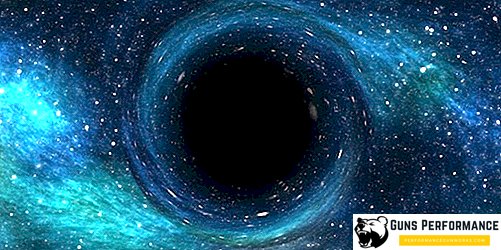The boundless universe is full of secrets, riddles and paradoxes. Despite the fact that modern science has made a huge leap forward in the exploration of space, much in this vast world remains incomprehensible for the human perception of the world. We know a lot about stars, nebulae, clusters and planets. However, in the vastness of the universe there are such objects, the existence of which we can only guess. For example, we know very little about black holes. Basic information and knowledge about the nature of black holes are built on assumptions and conjectures. Astrophysicists, nuclear scientists have been struggling with this issue for more than a dozen years. What is a black hole in space? What is the nature of such objects?

Speaking of black holes in simple language
To imagine what a black hole looks like, it is enough to see the tail of the train going into the tunnel. Signal lights on the last car as the train goes deeper into the tunnel will decrease in size until they completely disappear from view. In other words, these are objects where, due to monstrous attraction, even light disappears. Elementary particles, electrons, protons and photons are not able to overcome the invisible barrier, they fall into the black abyss of nonexistence, therefore such a hole in space was called black. There is not the slightest light area inside it, solid blackness and infinity. What is on the other side of the black hole is unknown.
This space vacuum cleaner has enormous gravity and is able to absorb a whole galaxy with all the clusters and superclusters of stars, with nebulae and with dark matter to boot. How is this possible? It remains only to guess. The laws of physics known to us in this case pop apart at the seams and do not provide an explanation for the processes taking place. The essence of the paradox is that in this part of the Universe the gravitational interaction of bodies is determined by their mass. The process of absorption by one object of another is not affected by their qualitative and quantitative composition. Particles, having reached a critical amount in a certain area, enter another level of interaction, where gravitational forces become forces of attraction. The body, object, substance or matter under the influence of gravity begins to shrink, reaching enormous density.
Approximately such processes occur during the formation of a neutron star, where stellar matter under the influence of internal gravity is compressed in volume. Free electrons combine with protons to form electrically neutral particles — neutrons. The density of this substance is huge. A particle of matter the size of a piece of refined sugar has a weight of billions of tons. Here it is appropriate to recall the general theory of relativity, where space and time are continuous quantities. Consequently, the compression process cannot be stopped halfway and therefore has no limit.

Potentially, a black hole looks like a hole in which there may be a transition from one segment of space to another. At the same time, the properties of space and time itself change, twisting into a space-time funnel. Reaching the bottom of this funnel, any matter falls into quanta. What is on the other side of the black hole, this giant hole? Perhaps there exists another other space where other laws apply and time flows in the opposite direction.
In the context of the theory of relativity, the theory of a black hole is as follows. The point of space, where gravitational forces have squeezed any matter to the microscopic size, has a tremendous force of attraction, the magnitude of which increases to infinity. A fold of time appears, and space is bent, closing at one point. Objects absorbed by a black hole are not able to resist the force of this monstrous vacuum cleaner. Even the speed of light, which quanta possess, does not allow elementary particles to overcome the force of attraction. Any body that has got to such a point ceases to be a material object, merging with the space-time bubble.

Black Holes in Science
If you ask, how are black holes formed? Definite answer will not be. There are a lot of paradoxes and contradictions in the universe that cannot be explained from the point of view of science. Einstein's theory of relativity allows only theoretically explain the nature of such objects, but in this case quantum mechanics and physics are silent.
Trying to explain the processes taking place by the laws of physics, the picture will look like this. The object is formed as a result of the colossal gravitational contraction of a massive or supermassive cosmic body. This process has a scientific name - gravitational collapse. The term "black hole" was first sounded in the scientific community in 1968, when American astronomer and physicist John Wheeler tried to explain the state of stellar collapse. According to his theory, in place of a massive star subjected to a gravitational collapse, a spatial and temporal failure arises, in which constantly growing compression acts. All that the star was made of goes inside itself.

This explanation allows us to conclude that the nature of black holes is in no way connected with the processes occurring in the Universe. Everything that happens inside this object does not reflect in any way on the surrounding space with one “BUT”. The gravitational force of a black hole is so strong that it bends space, forcing galaxies to rotate around black holes. Accordingly, it becomes clear the reason why galaxies take the form of spirals. How long it will take for the huge Milky Way galaxy to disappear into the abyss of a supermassive black hole is unknown. A curious fact is that black holes can occur at any point in outer space, where ideal conditions are created for this. Such a fold of time and space eliminates the enormous speeds with which the stars rotate and move in the space of the galaxy. Time in a black hole flows in another dimension. Inside this area, no laws of gravity are interpretable from the point of view of physics. This state is called the singularity of the black hole.

Black holes do not show any external identification signs, their existence can be judged by the behavior of other space objects affected by gravitational fields. The whole picture of the struggle for life and death takes place on the border of a black hole, which is covered by a membrane. This imaginary surface of the funnel is called the "event horizon." Everything that we see to this boundary is tangible and material.
Black Hole Scenarios
Developing the theory of John Wheeler, we can conclude that the secret of black holes is more likely not in the process of its formation. The formation of a black hole results from the collapse of a neutron star. Moreover, the mass of such an object must exceed the mass of the Sun three or more times. The neutron star shrinks until its own light is no longer able to break free from the tight embrace of gravity. There is a boundary limit in size to which a star can shrink, giving birth to a black hole. This radius is called the gravitational radius. Massive stars at the final stage of their development should have a gravitational radius of several kilometers.

Today, scientists have obtained indirect evidence of the presence of black holes in a dozen X-ray binary stars. X-ray stars, a pulsar or a burster do not have a solid surface. Moreover, their mass is greater than the mass of the three Suns. The current state of outer space in the constellation Cygnus - the X-ray star Cygnus X-1, makes it possible to trace the formation of these curious objects.
Based on research and theoretical assumptions, today in science there are four scenarios for the formation of black stars:
- gravitational collapse of a massive star at the final stage of its evolution;
- the collapse of the central region of the galaxy;
- the formation of black holes in the process of the Big Bang;
- the formation of quantum black holes.
The first scenario is the most realistic, but the number of black stars with which we are familiar today exceeds the number of known neutron stars. And the age of the Universe is not so big that so many massive stars could go through the full process of evolution.

The second scenario has the right to life, and there is a vivid example - the supermassive black hole Sagittarius A *, nestled in the center of our galaxy. The mass of this object is 3.7 mass of the sun. The mechanism of this scenario is similar to the scenario of a gravitational collapse with the only difference that an interstellar gas, rather than a star, is subject to collapse. Under the influence of gravitational forces, gas is compressed to a critical mass and density. At the critical moment, matter disintegrates into quanta, forming a black hole. However, this theory is doubtful, since recently astronomers at Columbia University have identified the black hole Satellites A * satellites. They turned out to be a lot of small black holes, which were probably formed in another way.

The third scenario is more theoretical and is associated with the existence of the Big Bang theory. At the time of the formation of the universe, a part of matter and gravitational fields underwent fluctuation. In other words, the processes went another way, not connected with the known processes of quantum mechanics and nuclear physics.
The latter scenario is focused on the physics of a nuclear explosion. In clots of matter in the process of nuclear reactions under the influence of gravitational forces, an explosion occurs, in place of which a black hole is formed. Matter explodes inward, absorbing all the particles.
The existence and evolution of black holes
Having an approximate idea of the nature of such strange space objects, something else is interesting. What are the true dimensions of black holes, how fast are they growing? The sizes of black holes are determined by their gravitational radius. For black holes, the radius of a black hole is determined by its mass and is called the Schwarzschild radius. For example, if an object has a mass equal to the mass of our planet, then the Schwarzschild radius in this case is 9 mm. Our main body has a radius of 3 km. The average density of a black hole formed in the place of a star with a mass of 10⁸ of the mass of the Sun will be close to the density of water. The radius of such education will be 300 million kilometers.

It is likely that such giant black holes are located in the center of galaxies. To date, 50 galaxies are known, in the center of which are huge temporary and spatial wells. The mass of such giants is billions the mass of the Sun. One can only imagine what a colossal and monstrous force of attraction has such a hole.
As for small holes, these are mini-objects whose radius reaches insignificant values, only 10 ¹ ² cm. The mass of such a crumb is 10 gr. Such formations arose at the time of the Big Bang, however with time they increased in size and today flaunt themselves in outer space as monsters. The conditions under which the formation of small black holes took place, scientists today are trying to recreate in terrestrial conditions. For these purposes, experiments are carried out in electron colliders, through which elementary particles are accelerated to the speed of light. The first experiments allowed to obtain in laboratory conditions a quark-gluon plasma - matter, which existed at the dawn of the formation of the Universe. Such experiments suggest that a black hole on Earth is a matter of time. Another thing is whether such an achievement of human science will turn into a catastrophe for us and for our planet. By creating an artificially black hole, we can open Pandora’s box.

Recent observations of other galaxies have allowed scientists to discover black holes, the size of which exceeds all imaginable expectations and assumptions. The evolution that occurs with such objects allows us to better understand how the mass of black holes grows, what its real limit is. Scientists have concluded that all known black holes have grown to their real size within 13-14 billion years. The difference in size is due to the density of the surrounding space. If a black hole has enough food within reach of gravity, it grows like yeast, reaching a mass of hundreds and thousands of solar masses. Hence the gigantic dimensions of such objects located in the center of galaxies. A massive cluster of stars, huge masses of interstellar gas are abundant food for growth. When galaxies merge, black holes can merge together, forming a new supermassive object.

Judging by the analysis of evolutionary processes, it is customary to distinguish two classes of black holes:
- objects with a mass of 10 times the solar mass;
- massive objects, the mass of which is hundreds of thousands, billions of solar masses.
There are black holes with an average intermediate mass of 100-10 thousand times the mass of the Sun, but their nature is still unknown. There is approximately one such object per galaxy. The study of X-ray stars made it possible to find two medium-sized black holes at once at a distance of 12 million light years in the galaxy M82. The mass of one object varies in the range of 200-800 solar masses. Another object is much larger and has a mass of 10-40 thousand solar masses. The fate of such objects is interesting. They are located near star clusters, gradually attracting themselves to a supermassive black hole located in the central part of the galaxy.
Our planet and black holes
Despite the search for a clue about the nature of black holes, the scientific world is concerned about the place and role of the black hole in the fate of the Milky Way galaxy and, in particular, in the fate of the planet Earth. The fold of time and space that exists in the center of the Milky Way gradually absorbs all objects existing around. Millions of stars and trillions of tons of interstellar gas have already been absorbed into the black hole. In time, the line will reach the arms of Cygnus and Sagittarius, in which the Solar system is located, having traveled a distance of 27 thousand light years.

Another nearby supermassive black hole is located in the central part of the Andromeda galaxy. It is about 2.5 million light years away from us. Probably, until our object Sagittarius A * swallows its own galaxy, we should expect the merging of two neighboring galaxies. Accordingly, the merging of two supermassive black holes into one whole, terrible and monstrous in size, will occur.
A completely different thing - small black holes. To absorb the planet Earth is quite a black hole with a radius of a couple of centimeters. The problem is that, by nature, a black hole is a completely faceless object. No radiation or radiation emanates from its womb, therefore it is rather difficult to notice such a mysterious object. Only at close range can we detect a curvature of the background light, which indicates that there is a hole in space in this region of the Universe.

To date, scientists have found that the black hole nearest to Earth is the V616 Monocerotis object. The monster is located 3000 light years from our system. In size, this is a large formation, its mass is 9-13 solar masses. Another close object that threatens our world is the black hole Gygnus X-1. With this monster we are separated by a distance of 6000 light years. Black holes detected in our neighborhood are part of the binary system, i.e. exist in close proximity to the star that feeds the insatiable object.
Conclusion
The existence in space of such mysterious and mysterious objects as black holes, of course, forces us to be on the watchman. However, everything that happens with black holes happens quite rarely, if we take into account the age of the Universe and huge distances. For 4.5 billion years, the Solar System is in a state of rest, existing according to laws known to us. During this time, nothing of the kind has appeared, nor has the space distorted or the folds of time near the solar system. There are probably no suitable conditions for this. That part of the Milky Way, in which the Sun's star system resides, is a calm and stable part of space.

Scientists assume the idea that the appearance of black holes is not accidental. Such objects perform in the Universe the role of orderlies who destroy the surplus of cosmic bodies. As for the fate of the monsters themselves, their evolution is not yet fully understood. Существует версия, что черные дыры не вечны и на определенном этапе могут прекратить свое существование. Уже ни для кого не секрет, что такие объекты представляют собой мощнейшие источники энергии. Какая это энергия и в чем она измеряется - это другое дело.

Стараниями Стивена Хокинга науке была предъявлена теория о то, что черная дыра все-таки излучает энергию, теряя свою массу. В своих предположениях ученый руководствовался теорией относительности, где все процессы взаимосвязаны друг с другом. Ничего просто так не исчезает, не появившись в другом месте. Любая материя может трансформироваться в другую субстанцию, при этом один вид энергии переходит на другой энергетический уровень. Так, может быть, обстоит дело и с черными дырами, которые являются переходным порталом, из одного состояния в другое.












